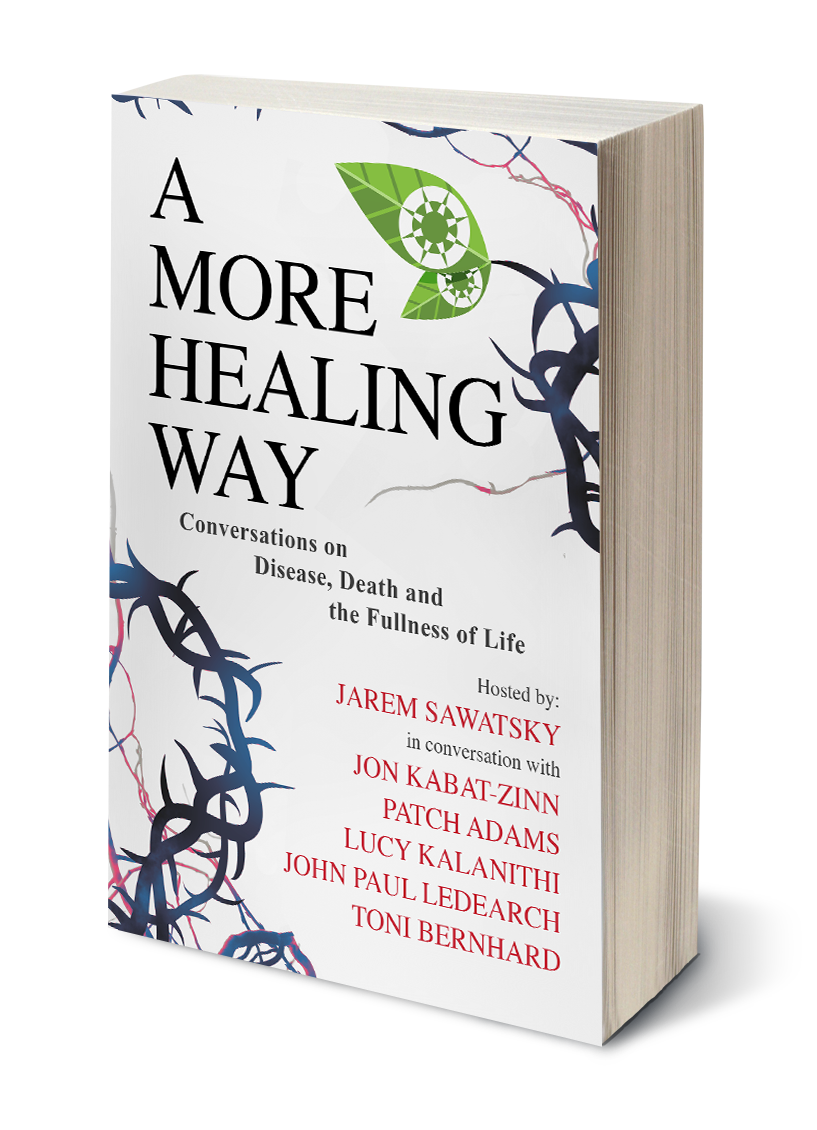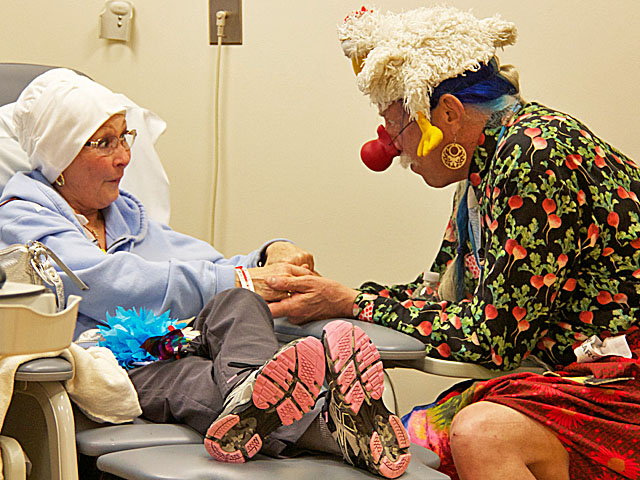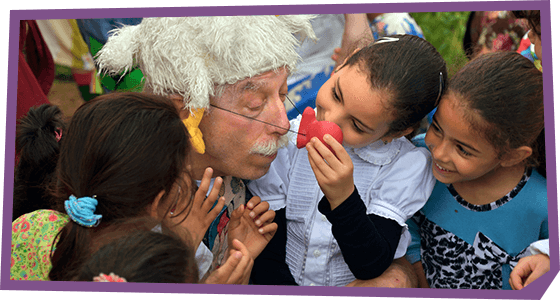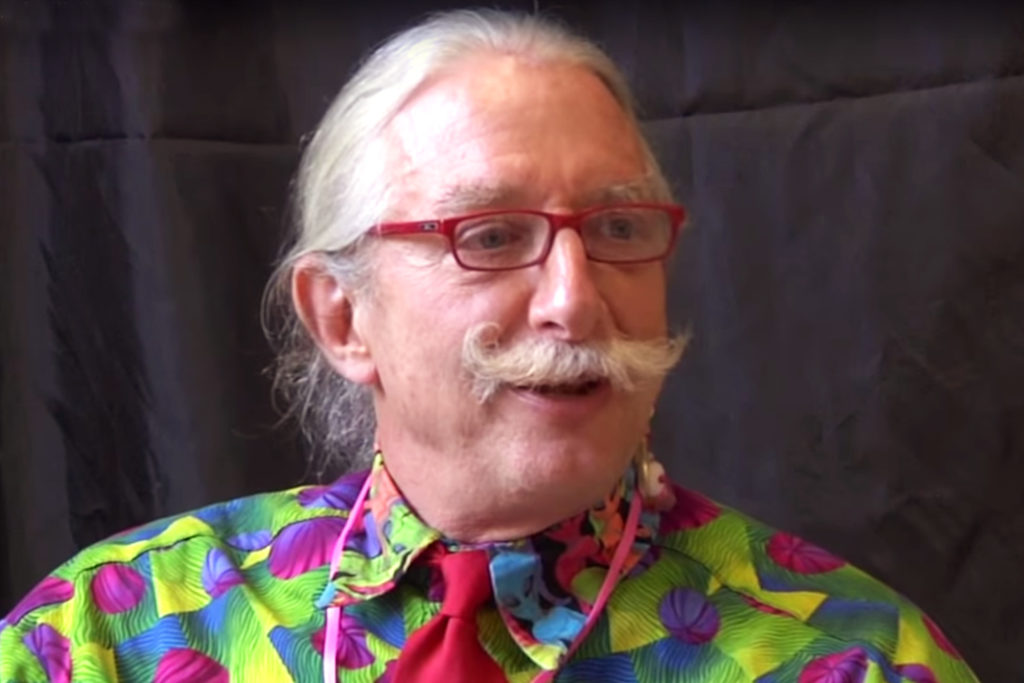
Where should I send the audio and video series?

Where should I send the audio and video series?
The real Patch Adams estimates he has been at 10,000 deathbeds. I asked him what he learned from being present at these deathbeds – dressed as clown with toys in his pocket.

“They are not deathbeds.” He said. “They are living beds. There are two states: living and dead. From the second you are conceived you are dying. That is not interesting – especially since you are also living.”
Then he looked into my eyes and said, “Either you’re living or you’re dead. The fact that you are ‘dying’… well, I see you as living. So where is the fun?” It was as if he was saying – you are living to live well.
Later in our conversation, I asked him if, given his experience, he could give a few hints on living well for those of us who are labeled with a disease.
“How many do want?” Then he sat back and said “For example, we die. Relax. The question is not ‘how’. The question is ‘are you living?’ Are you living? Are you being the human being you want to be? Are your relationships healthy? Are you grateful? What is your sense of wonder? What’s your sense of curiosity? What thrills you?
You can decide to love life. You can decide to love your partner. You can decide to know what I mean when I say, a tree can stop your suffering.”
Somehow those words struck me as free. I don’t need to figure out everything about dying. I need to keep living. To be thrilled, to be grateful, to be wonder-filled. To be curious about life and living. These are ways of being that are accessible to me.
As a person with Huntington’s Disease, I am seeking out those I hope can teach me about love, compassion and the joy of living. In a world of potential teachers, I’ve picked 5, including Patch Adams. The five are all wise teachers, living the wisdom of the future in the present and oriented to a more healing way of living in the here and now. I was recording a video with Patch Adams when he said these things.
If someone else spoke these words to me they probably would not have had the same effect. Perhaps if I tell you some of Patch Adams’ story, you too will feel the deep surge of gratitude for living and a deep dare that our living is shaped by caring for others.
Some people think they know Patch Adams’ story because of the famous Hollywood movie which was based on his life and featured Robin Williams as Patch Adams. However, the real Patch Adams is quick to point out how the film profoundly simplified and sanitized the life.

Patch was born in 1945. He grew up an army brat following his father around the world and watching as war stole his father’s soul. After his dad died during Patch’s teen years, his mom relocated Patch and his brother to Virginia. This was a time of open racism. When Patch saw “Whites Only” signs he realized his country was fake and religion was fake because they allowed such injustice and dehumanization. As a teen Patch was beaten up for standing against violence and racism. In his 18th year, he was hospitalized three times at a mental hospital for trying to commit suicide. Patch did not want to live in a world of violence.
It was during his third hospitalization that his life changed directions. For him it was like a lightning strike: “You don’t have to kill yourself. You need to make revolution, a love revolution”
He was confronted by two questions which shaped his life.
The first question set him on a quest to become a free doctor. The second led him to practice clowning every day.
At the age of 18, he says he “dove into an ocean of gratitude and has never found the shore.”
He says “since then, in 54 years, I never had a bad day.”
As a young adult, he turned his attention to books and to social experiments in loving and playing. Through these social experiments, he crafted himself into an instrument of peace. He dressed as a clown so that he could clown instantly if he saw someone in need of comfort. Sometimes he clowned to interrupt violent exchanges between strangers. For two hours, every day for 2 years he called wrong numbers to learn to talk, trying to keep them on the phone He would go into Washington DC to ride the elevator to learn the art of talking.
For Patch, medical school seemed to teach everything that was wrong with society: elitism, racism, speed doctoring, medicine for money, hierarchy
The year he graduated as a medical doctor, 1971, he also released an 8-page paper on a model hospital designed for holistic care. He called the model hospital Gesundheit! Institute
To demonstrate that his model of care could work, for the next 12 years a small group of families and doctors lived out a mini-version of the model.
Here are some of the striking characters of this model of care:
When Patch started this Gesundheit! Institute, they thought the full model hospital would be built by 1975. Yet during this 12 years, they did not get one donation. They learned that giving and loving was a kind of a high. But they also learned that they would need to change their approach if they wanted to find funds to build the model hospital.
Patch then started to work full-time at various kinds of outreach and speaking engagements. The goal was to create the funds to build the model hospital. A dream that is yet to be completed. (You can donate here: http://www.patchadams.org/donate/ ), Patch spends up to 300 days each year on the road and visits over 90 medical universities, 70 countries. Apart from doctoring Patch finds he needs to have some ongoing way to care for others if he is to sustain his work. So he responds to every letter written to him as an act of care. Further, he decided to do clowning trips into some of the neediest places in the world: war zones, refugee, orphans, prisons, abject poverty, even war veteran trips. In each place, they try to inflict society with the joy of living.
Patch sums up his approach by saying: “my spiritual path is loving people.”
 So when I speak to Patch, across from me sits a 71-old man. He is dressed as a clown, with long white and dyed blue hair that has not been cut since 1967. In characteristic style, his white mustache curls up at the ends. He wears a tie that’s pink and purple and some bright red glasses to finish off the outfit. Across from me sits a man whose dream has not yet been accomplished, even through four decades of trying. But as he speaks, I know this is an unimportant detail. He speaks with love, not bitterness. His life has not been wasted trying to fund a model hospital. Rather, this one speaks as one who tries every day to be an instrument of peace, justice, and care. I am the peace professor but he speaks as one whose whole life has been dedicated to peace or what he calls 6 qualities of living well: happy, funny, loving, cooperative, creative and thoughtful.
So when I speak to Patch, across from me sits a 71-old man. He is dressed as a clown, with long white and dyed blue hair that has not been cut since 1967. In characteristic style, his white mustache curls up at the ends. He wears a tie that’s pink and purple and some bright red glasses to finish off the outfit. Across from me sits a man whose dream has not yet been accomplished, even through four decades of trying. But as he speaks, I know this is an unimportant detail. He speaks with love, not bitterness. His life has not been wasted trying to fund a model hospital. Rather, this one speaks as one who tries every day to be an instrument of peace, justice, and care. I am the peace professor but he speaks as one whose whole life has been dedicated to peace or what he calls 6 qualities of living well: happy, funny, loving, cooperative, creative and thoughtful.
Talking with Patch made me reflect on this question: What if the answer to most of our problems is to make others radiant? When we are not well, so many medical professionals tell us to focus on ourselves. But what if the key to our own happiness can only be opened by caring for others.
From Patch, I want to learn the joy of living, the gift of living in gratitude and the deep transformations what arise when care and love those around us. My blog outlines my own social experiments in loving but Patch dare to me go further, bolder and freer.
I interviewed Patch for my upcoming book, Dancing with Elephants: Mindfulness Training For Those Living With Dementia, Chronic Illness or an Aging Brain. I am also using the video from that interview as 5-part series: A More Healing Way: Video Discussions on Disease.
In the video, you can hear Patch share his own story as well as exploring things like how a tree can stop your suffering; how loneliness is the worst human condition, tricks to get people to love and to be joyful. Use the box below to sign up for the videos.
friendly passage chap
Blessings on you and your work in sharing (and teaching the power of) the gift of gratitude.
Wonderful blog Jarem, I am happy to know you, Steve.
Thank you for the wonderful article.My people here in Kenya here where doctors have been on strike since December 2016 will be happy to read it and feel encouraged.
Great blog and interview, Jarem. Can’t wait to see the whole interview on video. I am grateful for the emphasis that our focus should be on others, caring for them, making them happy. Caring for self is important but it is easy to get lost in wilderness of self and identity. Living and life becomes clear, including who I am, when doing good and pursuing justice for others.
Thanks for this great interview. As an on call spiritual care practioner in large downtown hospital, I mostly attend to dying patients and families in crisis. Patch Adam’s insight to see them as “living beds” will help me prepare myself for tonight – when I turn on my page, not knowing what to expect. I agree with Jarem that I don’t have to have it all figured out. This blog was a great reminder to live the life I’ve been given. To wonder, to be curious. I’ve found being grateful for what and who I am is more life giving than trying to figure it all out. Blessings on the book. Peace out.
Thanks for the update on Patch. I’ve admired him for many decades. Was nice to hear his whole story and what you are doing. I’d love to read your book. One thing which hit me hard was about loneliness,as I’m having a hard time with that right now ! Even though I live in the semi – Paradise of Maui, Hawaii and have family inc. g kids and one g g kid, i’m getting old and don’t have many close friends anymore and I’m single. Being an elder is hard to accept at times too. But I try to be positive to all people and promote peace and justice as well. You just gotta keep on smiling and keep on truckin !!! Aloha, Ken Hess